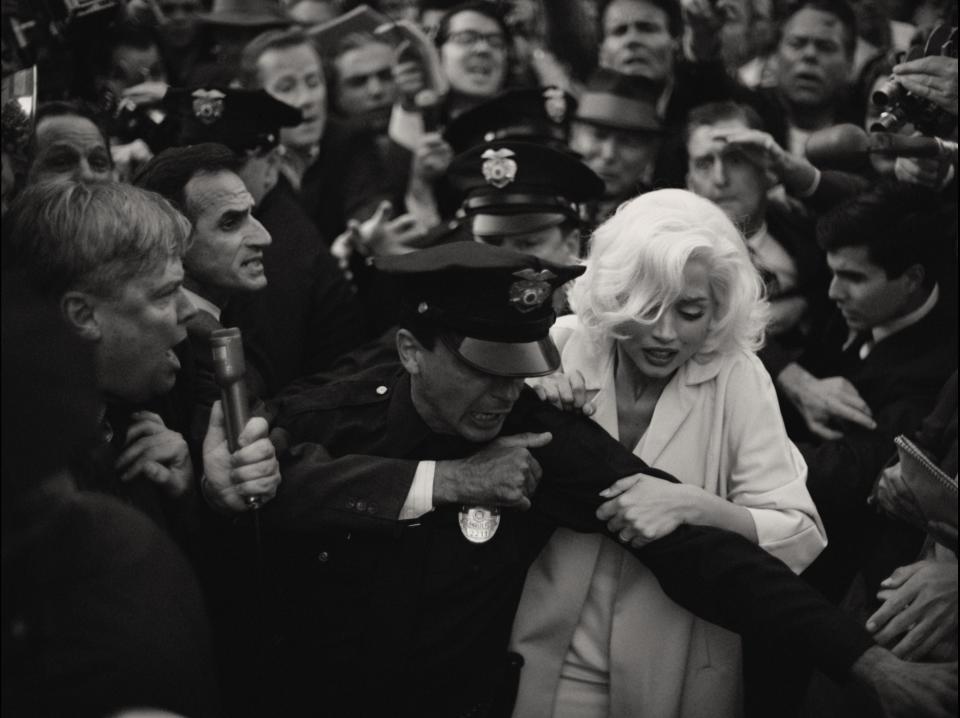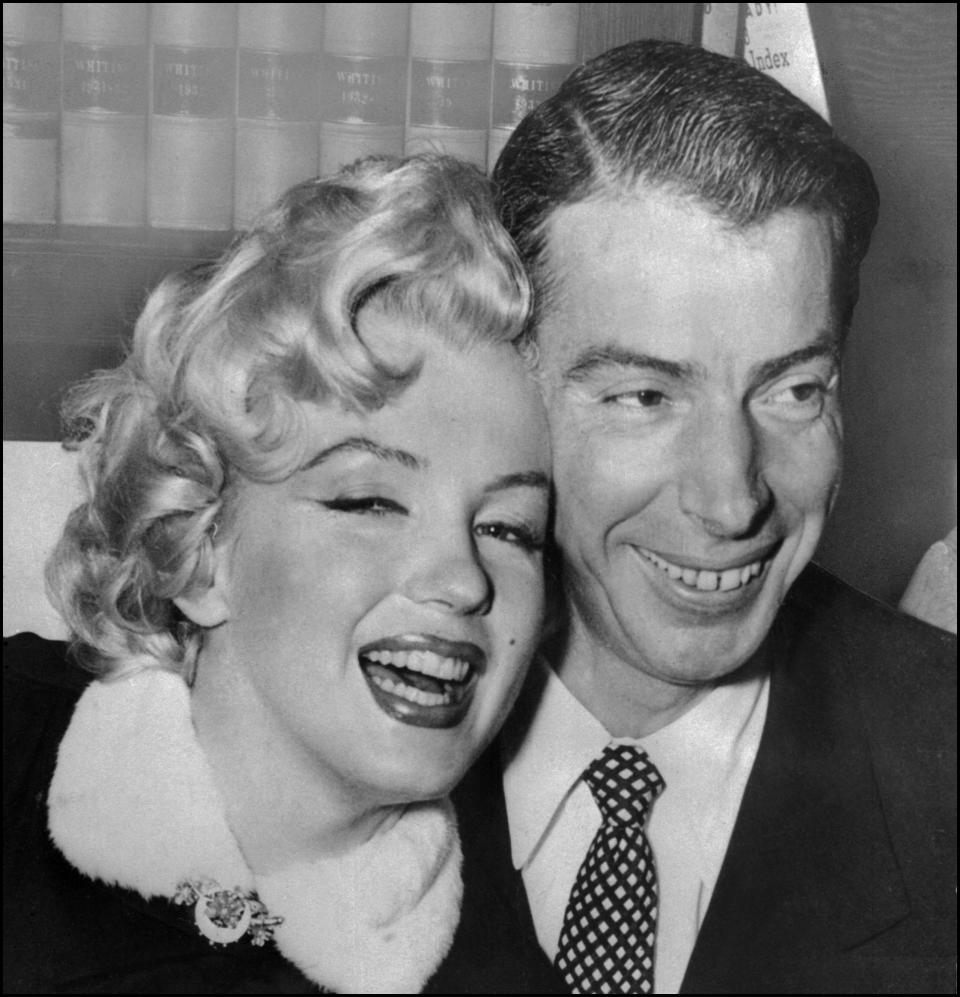'Blonde' fact-check: Did Marilyn Monroe really have a threesome with Charlie Chaplin's son?
- Oops!Something went wrong.Please try again later.
- Oops!Something went wrong.Please try again later.
Spoiler alert! The following contains important plot points of Marilyn Monroe drama "Blonde" (now streaming on Netflix).
If you’re anything like us, you probably have a lot of questions after watching “Blonde.”
Netflix’s controversial Marilyn Monroe drama (now streaming) stars Ana de Armas as the tragic Hollywood starlet, who died of an overdose in 1962 at 36. The film is based on Joyce Carol Oates’ 2000 historical fiction novel, which traces her humble beginnings as Norma Jeane Baker to her fame, and how she became a victim of a leering, male-dominated industry.
“The film is about the meaning of Marilyn Monroe and why she endured,” director Andrew Dominik says. Here’s some of what's fact and fiction in the critically divisive “Blonde”:
'It feels like serendipity': Ana de Armas' improbable transformation into Marilyn Monroe in 'Blonde'
'Blonde' review: Ana de Armas is a bombshell but Netflix's Marilyn Monroe movie is brutal misery
Did Marilyn Monroe have a threesome with Charlie Chaplin Jr.?
Early in the film, Marilyn meets Charlie "Cass" Chaplin Jr. (Xavier Samuel) and Eddy G. Robinson Jr. (Evan Williams) in an acting class, and they go home together to have a threesome. The new friends soon form a "throuple," having constant sex and laughs and becoming tabloid fodder. But Marilyn's relationship with Cass and Eddy ends after she becomes pregnant with one of their babies and is forced to get an abortion.
"There is no evidence of a three-way between Chaplin Jr. and Robinson Jr.," says Monroe historian and collector Scott Fortner. "It is true, however, that Marilyn dated Chaplin Jr. for a short period of time. He writes about this in his biography (1960's 'My Father, Charlie Chaplin')."
Did Marilyn's mother really try to drown her in a bathtub?
The film traces young Marilyn, then known as Norma, and her traumatic childhood living with her single mom, Gladys Pearl Baker (Julianne Nicholson). She repeatedly blames her daughter for the departure of Norma's father and is both emotionally and physically abusive. At one point, Gladys tries to drown Norma in a bathtub. Norma escapes and runs to her neighbors' apartment, and Gladys is sent to a mental hospital shortly after.
There is no evidence that Baker ever tried to drown her daughter, Fortner says. But Monroe's third husband, playwright Arthur Miller, said in a 1968 interview that Monroe told him her mother had threatened her life three times, according to Keith Badman's book, "Marilyn Monroe: The Final Years." Monroe was not close to her mom but continued to pay her medical bills. Baker outlived her daughter by 22 years, dying in 1984 at age 81.
"It’s true that Gladys suffered from mental problems and was indeed institutionalized for most of her adult life," Fortner says. "There was a short period of time when Marilyn lived with her mother when she was young. Most of Marilyn’s childhood, however, was spent with foster families and she had a brief stint at Hollygrove, an LA orphanage. She married her first husband at 16 in order to avoid having to return to the orphanage."

Did she never know her father?
Throughout "Blonde," Marilyn is constantly pining for and chasing after her absent father – he's the last image she sees in her mind just before she dies. It's true that she never knew her dad, Charles Stanley Gifford, Dominik says. As depicted in the film, Monroe reportedly did try to find him several times.
"It's well-documented," Dominik says. "There are many, many (instances) that were described in her actual life of her getting a driver out to some town in California. She would go and call her father in a phone booth, and then come back in tears saying that the guy refused to meet her."

Did Marilyn really get paid a fraction of Jane Russell's salary?
In the movie, before Marilyn signs on to 1953's "Gentlemen Prefer Blondes," she questions why she's only being offered $5,000 compared to her co-star Jane Russell's $100,000 salary. Monroe was really paid roughly $15,000 for the musical comedy, while Russell – who had been working for longer and was more well known – made about $150,000.
"It was during ('Gentlemen') that Marilyn started to pursue more recognition for her work and greater respect," Fortner says. "She knew she was becoming more popular among moviegoers and more famous. When the studio informed her that she wasn’t a star, Marilyn responded sharply with, 'Well, whatever I am, I AM the BLONDE.' "
What actually happened between Marilyn and JFK?
"Blonde" depicts a horrendous and degrading relationship between Marilyn and President John F. Kennedy (Caspar Phillipson). She exclaims that she's being treated like "a piece of meat" as Secret Service agents physically carry her to Kennedy's suite. There, in a drug- and booze-filled haze, the president forces her to perform oral sex before raping her.
"The vile sex scene between Marilyn and JFK is definitely fiction," Fortner says. "Opinions vary widely on the actual relationship between the two. Of course, there have been rumors for years, but what we think we know is that Marilyn and JFK met on no more than four occasions between October 1961 and August 1962," each time at a party. (The last, on May 19, 1962, was Kennedy's birthday gala at New York's Madison Square Garden, where Marilyn famously crooned "Happy Birthday, Mr. President.")

Did Joe DiMaggio ever abuse Marilyn?
In one scene, "Blonde" shows Marilyn's second husband, New York Yankees player Joe DiMaggio (Bobby Cannavale), berating Marilyn when she gets home, before beating her off screen. DiMaggio and Monroe, who filed for divorce after only nine months of marriage in October 1954, never commented about the alleged abuse publicly, and there are conflicting reports about the incident, Fortner says.
"But some close to her claimed Marilyn was bruised after an argument with Joe following the filming of the subway/skirt-blowing scene in 'Seven Year Itch,' during which Joe became visibly upset and left," Fortner says. "Makeup man Allan Snyder and hairstylist Gladys Whitten both claimed the next morning the bruises needed to be covered with makeup. Others have also commented on seeing bruising while Marilyn and Joe were married."
This article originally appeared on USA TODAY: 'Blonde': What's fact, what's fiction in Marilyn Monroe Netflix movie

